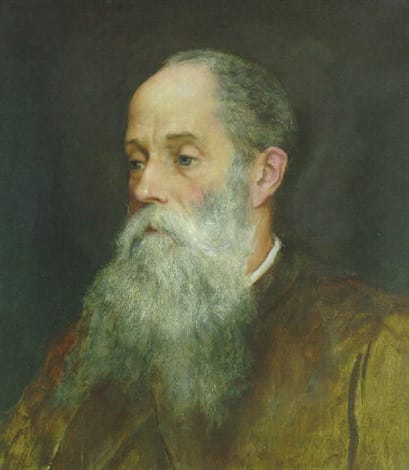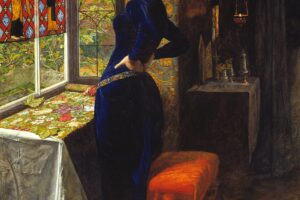Table of Contents
Overview
Love and the Maiden (1877) by John Roddam Spencer Stanhope is a radiant Pre-Raphaelite allegory where myth, nature, and emotion converge. The painting shows the winged figure of Love advancing toward a maiden seated beneath flowering trees. His fiery wings and golden torch blaze with urgency, while she gazes upward, hesitant yet captivated.
Stanhope, a central figure of the second wave of Pre-Raphaelites, infused the work with jewel-like color, mythological symbolism, and Renaissance clarity. It is both a celebration of love’s sudden arrival and a meditation on innocence confronted with desire.
The Story Behind the Painting
Inspiration and Symbolism
The subject is allegorical rather than literary, drawing on classical personifications of Love (Eros or Cupid) and the timeless theme of encounter between human and divine. Here, Love is not playful but commanding — a winged figure of fiery presence who disrupts the quiet solitude of the maiden.
To Victorian audiences, the painting spoke to the mysteries of love and destiny. The maiden, poised between youth and womanhood, becomes every figure who hesitates at the threshold of passion.
Stanhope’s Artistic Vision
John Roddam Spencer Stanhope (1829–1908), cousin of Rossetti and friend to Burne-Jones, belonged to the circle of “second generation” Pre-Raphaelites. He was known for symbolic works blending myth, allegory, and decorative beauty. Painted in Florence in 1877, Love and the Maiden reflects his fascination with Renaissance art, his mastery of color, and his interest in allegorical storytelling.
A Victorian Allegory of Love
The painting mirrors broader Victorian concerns: the balance between innocence and awakening, destiny and choice. Love here is not mere sentiment but an elemental force, arriving with brilliance and command.
Composition and Subjects
The Maiden in Reverie
On the left, the maiden reclines in a meadow dotted with violets and wildflowers. Her robes of violet, rose, and white fold in angular precision, painted with Stanhope’s jewel-like clarity. Her expression is thoughtful, even hesitant, as she turns her gaze toward Love. She embodies the moment before surrender — the pause between innocence and embrace.
Love Descends
Opposite her, Love advances with urgent grace. His wings blaze crimson and orange, catching the light like flames. His tunic glows with fiery patterns, echoing his role as a disruptive, consuming force. He leans forward, torch raised, his gesture insistent: love arrives not as suggestion but as command.
Figures in the Distance
In the background, other maidens walk in harmony, their presence contrasting with the central drama. They represent innocence untouched by passion, a reminder that love is a fate not yet encountered by all. Their placement deepens the allegory: while some walk untroubled, one has been chosen.
The Garden of Allegory
The setting is lush with flowering trees, heavy with roses and blossoms. Nature is not mere backdrop but participant, echoing the themes of growth, blossoming, and inevitable change. The twisting tree trunk between the figures stands as a natural barrier, symbolizing both separation and the moment of crossing into a new destiny.
Art Style and Techniques
Jewel-like Palette
Stanhope employs brilliant contrasts — fiery oranges and crimsons for Love, soft violets and whites for the maiden. The harmony of complementary colors heightens the dramatic tension between them. The blossoms and greenery are painted with the Pre-Raphaelite devotion to truth in nature, each leaf and petal rendered with precision.
Renaissance Influence
The frieze-like arrangement of figures, the sculptural drapery, and the architectural clarity of form reveal Stanhope’s debt to Italian Renaissance painting. His years in Florence left an indelible mark on his art, blending Pre-Raphaelite symbolism with classical composition.
Allegorical Precision
Every element is carefully chosen: the flowers beneath the maiden’s feet, the torch of Love, the flowing drapery, the distance between the two central figures. This precision gives the painting a decorative harmony while reinforcing its allegorical meaning.
Legacy and Reflection
Place in Stanhope’s Oeuvre
Love and the Maiden stands as one of Stanhope’s most celebrated works, encapsulating his gift for allegory, color, and narrative clarity. It bridges Pre-Raphaelite ideals with Aesthetic Movement tendencies, emphasizing beauty as well as symbolism.
Enduring Meaning
Today, the painting continues to resonate as a vision of love’s power — disruptive, transformative, and inevitable. The maiden’s hesitation, Love’s insistence, the blossoms in bloom: all remind us that love arrives unbidden, altering the course of life forever.
In a meadow beneath flowering trees, Love advances and the maiden pauses, her heart on the edge of change. Stanhope captures the instant where innocence meets passion, where destiny first makes itself known — a timeless allegory painted in flame and blossom.
About Artist

John Roddam Spencer Stanhope (January 20, 1829 – August 2, 1908) was an English artist associated with the second wave of the Pre-Raphaelite movement. Born into an aristocratic family in Cawthorne, Yorkshire, he was educated at Rugby School and Christ Church, Oxford. Despite his privileged background, Stanhope pursued a career in art, training under George Frederic Watts and traveling extensively, including trips to Italy and Asia Minor.
Artist Style and Movement
Stanhope’s work is typically classified within the later Pre-Raphaelite and Aesthetic movements of Victorian art. He worked across various media—oil, watercolor, fresco, tempera—and his subjects ranged from mythological and allegorical themes to biblical scenes and contemporary life. His early paintings featured highly original narrative compositions, which later evolved towards a more symbolic and aesthetic style influenced by broader Victorian artistic trends.
The Pre-Raphaelite Society continues to explore and share the legacy of this remarkable movement.
Artwork Profile
- Thoughts of the Past (1859), his first exhibited painting, depicting a contemplative woman by a window overlooking the Thames.
- The Shulamite: (Pastoral Scene with Lambs) (c. 1878), a serene and lyrical pastoral scene exemplifying his Pre-Raphaelite style.
- The Shulamite: (Bridal Procession) (c. 1882), depicting the procession with rich symbolism and ornate detail, continuing his Pre-Raphaelite themes.
- Penelope (1864), illustrating the faithful wife from Homeric legend in the detailed and expressive Pre-Raphaelite manner.
- Winnowing (c. 1880), portraying agricultural life with symbolic overtones typical of his narrative approach.
- Juliet and Her Nurse (c. 1860), a literary subject rich with emotional and dramatic qualities favored by Pre-Raphaelites.
- Why Seek ye the Living Among the Dead (1870–1899), a powerful biblical scene reflecting later symbolic and aesthetic tendencies.
- Love and the Maiden (1877), a romantic and allegorical composition showcasing his mature style.
- Charon and Psyche (1883), a mythological painting exploring themes of love and the afterlife.
- Pine Woods at Viareggio (1888), a landscape reflecting his time in Italy with delicate naturalism.
- The Gentle Music of a Bygone Day (1873), a nostalgic genre painting evoking memories and emotion.
- The Waters of Lethe by the Plains of Elysium (1880), a symbolic work referencing classical mythology and the afterlife.
John Roddam Spencer Stanhope’s artistic career reflects a rich engagement with the ideals of the Pre-Raphaelites, combined with a move towards aesthetic symbolism in later years. His work, characterized by technical skill and narrative depth, secured him a distinctive place in Victorian art history. Living much of his later life in Florence, he influenced subsequent artists including his niece Evelyn De Morgan, solidifying his legacy as a key figure bridging English Romanticism and Aestheticism.phasize classical virtue and patriotic sacrifice, reflecting the cultural ideals of his age.



